







The Workforce Intelligence Network for Southeast Michigan (WIN) is a workforce collaborative comprised of seven Michigan Works! Agencies (MWAs) and nine community colleges in a 19-county region representing approximately 63% of the total labor force in Michigan The counties in the WIN partnership include Clinton, Eaton, Genesee, Hillsdale, Huron, Ingham, Jackson, Lapeer, Lenawee, Livingston, Macomb, Monroe, Oakland, Saint Clair, Sanilac, Shiawassee, Tuscola, Washtenaw, and Wayne
The WIN data and research team analyzes job posting data at the occupation level within 11 customized occupation groups built using specific Standard Occupational Classification (SOC) codes to provide more contextualized information. Occupation groups combine data for jobs with similar skillsets, educational attainment, and experience requirements, which provides a more in-depth snapshot of the current labor market when compared to traditional industry data based upon North American Industry Classification System (NAICS) codes. Occupation outlook sections utilize these metrics to identify and display the top in-demand jobs, their entry requirements, and their earning potential
This report highlights labor market information and real-time job posting data for the City of Detroit, including a workforce overview that identifies key components of the area’s labor market such as labor force status, demographic, and commuting data The WIN analysis of online job postings, a proxy for employer demand, is a pioneering method for tracking the labor market’s health This data is used to provide real-time demand and job posting information for both employers and job seekers This report analyzes the fourth quarter 2024 labor market information from the City of Detroit for the Business and Finance, Energy, Healthcare, Information Technology (IT), and Skilled Trades occupation groups
WIN also generates a WIN Region quarterly report covering a 19-county region, utilizing data from all 11 occupational groups. Additionally, a separate quarterly report for the City of Detroit focuses on five occupational groups relevant to the local labor market. Annually, county-specific reports are produced, each highlighting five occupational groups selected to represent the unique labor market of that county.
For more information pertaining to the labor market in southeast Michigan, the custom occupation groups within this report, or any other workforce-related data projects, please visit WINintelligence org or contact the data and research team at info@WINintelligence org
There was a slight decrease in the total labor force during the fourth quarter of 2024, with a larger increase in the unemployment rate at 4 0 percent While the size of the labor force increased by 2 1 percent from 2023, the number of unemployed workers saw a 29 3 percent increase from 2023, and the number of employed individuals decreased by 0 1 percent from 2023
Registered Nurses top the list as the most demanded occupation, accounting for 2,361 job postings. The Health Care occupation group is the most in-demand occupation only 130 job postings above Business and Finance in the City of Detroit.
Annual Labor Market Information
The labor force in Detroit has recovered from the pandemic and increased between 2023 and 2024 by 5,353 individuals, from 249,915 to 255,268 individuals Employment decreased by 141 individuals (or 0 1 percent) and unemployment numbers increased by 5,495 individuals (or 29.3 percent), respectively.
Quarterly Employer Demand Overview
The fourth quarter of 2024 shows that employer demand has decreased from Q3 2024 In Q4 2024, there was an average of 16,873 unique postings per month in the City of Detroit, a decrease of 408 monthly postings from the 17,281 monthly averages recorded in Q3. The third quarter in 2023 had the highest job postings with an average monthly 20,683 postings and the fourth quarter in 2023 had the lowest postings with 16,251 monthly average postings The overall decrease in recent job postings could be due to many different reasons and is not necessarily a negative indicator of the economy
Annual Labor Force, Employment, Unemployment Rate
2014–2024

Average Quarterly Posting Analysis City of Detroit Q3 2023 - Q4 2024
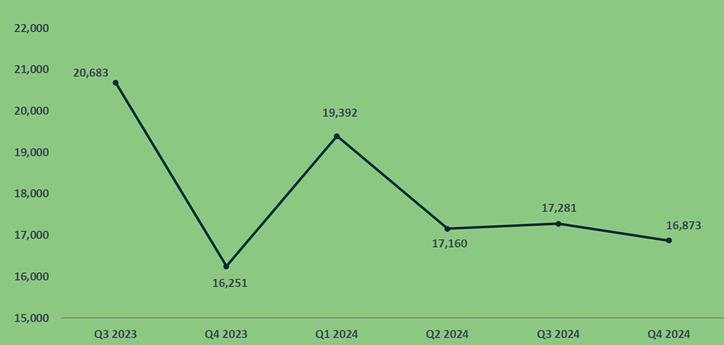
2.4%
Employer demand decreased by 2.4 percent, a loss of 408 job postings since Q3 2024
Most in-demand minimum education level during Q4
227,307
a decrease of 4,206 workers since Q3 In Q4, employment totaled
During Q4 2024, there were 30,735 job postings in the City of Detroit Health Care, Business and Finance, and Information Technology occupation groups were the highest posting employers in Q4 The top posted job occupations include Registered Nurses; Computer Occupations, all other; Sales Representatives, Wholesale and Manufacturing, Except Technical and Scientific Products; and Software Developers More information about in-demand job postings is available on page 7.
Of the 30,735 unique postings in the city of Detroit during Q4 2024, 12,107 (39.4 percent) required a Bachelor’s degree. An additional 4,404 postings (14 percent) required an advanced degree. The high demand for business and finance and information technology roles within the city drives this high demand for college education

Education
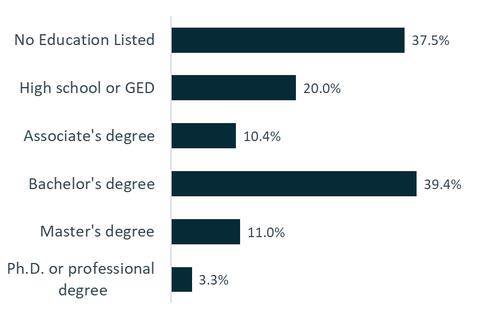
For Q4 2024, Labor Force participation decreased by 5,296 individuals (2.0 percent) over Q3 2024. Employment also decreased by 4,206 workers from Q3 2024, and unemployment figures showed an increase of 5,334 from Q4 2023 to Q4 2024 with 26,311 individuals in Q4 2024. Also, the unemployment rate decreased by 0.2 percent from the previous quarter for an overall Q4 2024 unemployment rate of 10.4 percent More information regarding this year’s unemployment rate and other labor market indicators can be found on page 4

The labor force in the City of Detroit experienced growth year over year from 2015 through 2020 and peaked in 2020 with 262,129 workers. During the pandemic, the labor force marked a 7.7 percent decline to 241,955 in 2021 but has since increased to 255,268 in 2024. Employment showed a similar trend, with growth year after year from 2012 through 2019. The COVID-19 pandemic ushered in a significant drop, with employment dipping 10.2 percent in 2020 over 2019. Employment figures seem to have stabilized in 2024 following the postpandemic recovery Meanwhile, the number of unemployed individuals in the City of Detroit increased by 5,495 workers, or 29 3 percent, between 2023 and 2024

Data: Bureau of Labor Statistics
During 2023, there were 269,746 individuals in the labor force, meaning they were either working or seeking employment. Employed workers make up 85.9 percent of the city's labor force. The highest unemployment rates in 2023 were those individuals 24 years old or younger Within this age cohort, there were 56 0 percent of unemployed individuals identifying as males compared to 45.4 percent of unemployed individuals identifying as female. Overall, males had a higher unemployment rate than females, at 15.2 percent and 13 1 percent respectively Native Hawaiian and Pacific Islander job seekers faced the most challenge in securing employment, with an overall unemployment rate of 80.6 percent. This group was followed by Native American job seekers at 15.7 percent.

According to data from the most recent Census Bureau 2023 ACS Five-Year estimates, the City of Detroit population decreased by about 0.02 percent between 2022 and 2023. During 2023, there were 636,644 people living in the city. The gender of the populace was split almost evenly, with about 52.5 percent of the population identifying as female and the other 47.5 percent identifying as male. A majority of the population identified as Black or African American (76.8 percent) with the second largest number of individuals identifying as White (11 7 percent) The region is facing an aging populace; with 26 5 percent of the population over the age of 54, compared to 34 2 percent under the age of 25
Population Gender Demographics
Population Race Demographics
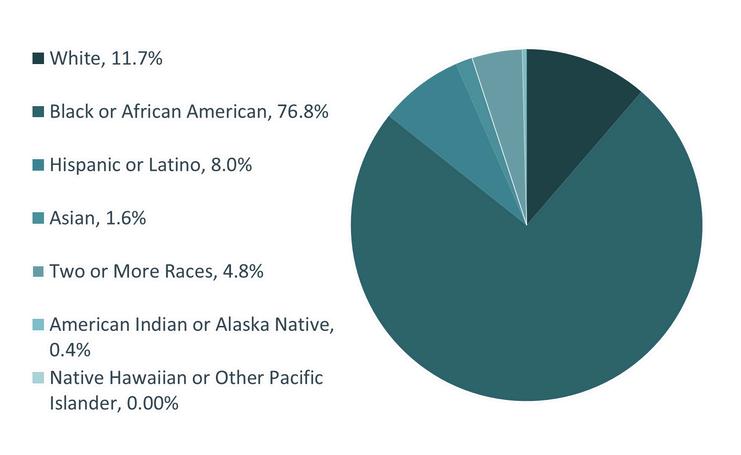
Population Age Demographics
According to the most recent OnTheMap data set from the Census Bureau, Detroit's 2021 workforce consisted of 170,053 individuals There were 51,963 (30 6 percent) residents also worked in the city, while the remaining 118,090 residents (69 4 percent) traveled outside for work With 217,738 workers employed in the city during 2021, there were 165,775 (76 1 percent) workers living outside of the city and commuting in While there is a higher percentage of both inbound and outbound commuters in Detroit than other areas of the WIN regions, Detroit is ultimately a net importer of jobs, with more workers commuting into the area for employment



Registered Nurses are the highest in-demand occupation during Q4, with 2,361 unique online job postings. Computer Occupations, all Other are the second largest occupation with 832 postings. Sales Representatives, Wholesale and Manufacturing, Except Technical and Scientific Products (635 postings) round out the top three occupations in Q4 Many of these positions require a Bachelor's degree, which is common in over half of the top 20 posted jobs in the city

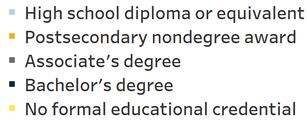
Entry-level jobs, which usually require zero to two years of previous experience, account for 23.5 percent of postings in Detroit. Three of the top ten entry level occupations require a Bachelor’s degree, while the remaining seven require a High School diploma, postsecondary non-degree award, or Associate degree Those who enter the workforce with a college degree can expect entry wages nearly double from those without Registered Nurses were the top posted entry-level jobs with 794 postings requiring zero to two years of experience and a Bachelor’s degree.
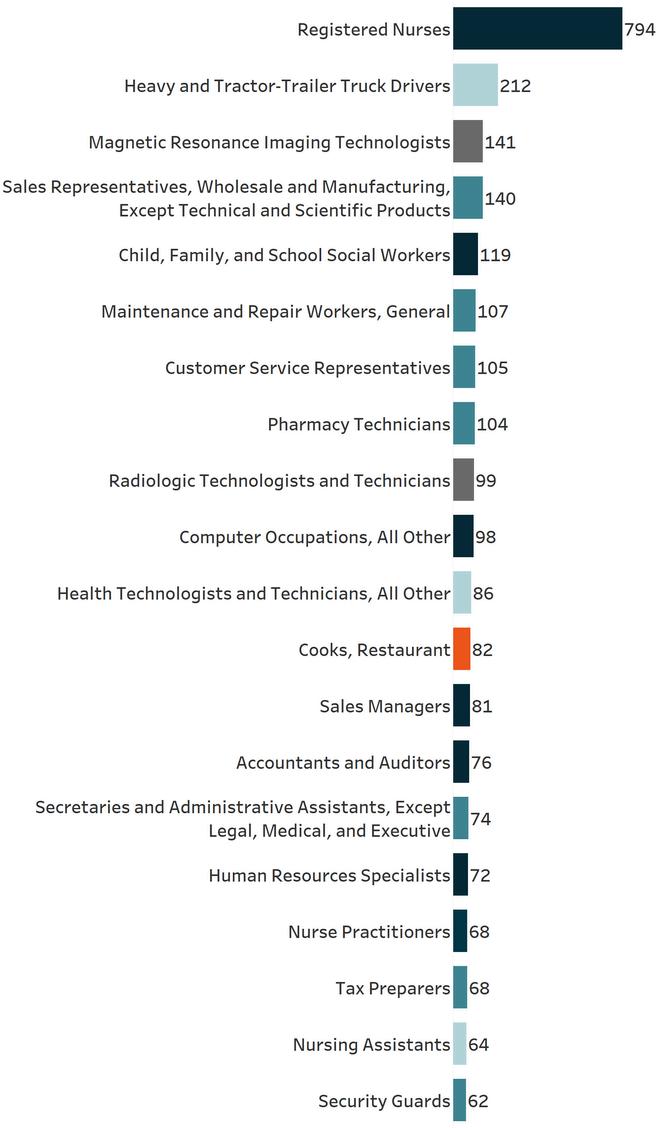

Henry Ford Health
Accenture
Deloitte
Detroit Medical Center
Tenet Healthcare
Dmc Sinai Grace Hospital
Wayne State University
GPAC
City Of Detroit
PricewaterhouseCoopers
Dmc Harper University Hospital
DTE Energy
R1 RCM
Blue Cross Blue Shield
Rocket Companies
Ernst & Young
Dmc Children's Hospital Of Michigan
Canonical Group
Aerotek
McLaren Health Care
*Employer names are listed as they appear in online job postings.
Project Management
Nursing
Marketing
Auditing
Accounting
Finance
Workflow Management
Customer Relationship Management
Data Analysis
Selling Techniques
Communication
Management
Customer Service
Leadership
Operations
Problem Solving
Sales
Detail Oriented
Planning Writing
Valid Driver's License
Registered Nurse (RN)
Basic Life Support (BLS) Certification
Cardiopulmonary Resuscitation (CPR)
Certification
Advanced Cardiovascular Life Support (ACLS) Certification
Master Of Business Administration (MBA)
American Registry Of Radiologic
Technologists (ARRT) Certified
American Red Cross (ARC) Certification
Teaching Certificate
Licensed Practical Nurse (LPN)
Certified Public Accountant
Board Certified/Board Eligible
Certified Nursing Assistant (CNA)
Project Management Professional
Certification
Commercial Driver's License (CDL)
Nurse Practitioner (APRN-CNP)
Certified Patient Care Technician (CPCT)
First Aid Certification
Certified Information Systems Security
Professional
Licensed Master Social Worker
Jobs in the Business and Finance occupation group can be found in nearly every type of establishment throughout the city. These workers require strong mathematical and accounting abilities along with project management and planning skills. Workers in this occupation group are in high demand in Detroit.

249 Business and Finance Workers
0.7 % increase from 2023
Business and Finance Education and Experience
The Business and Finance occupation group offers high paying job opportunities for workers A Bachelor's degree is the most in-demand education level in Q4, as noted in 3,860 postings. A Master's degree is the second most in-demand education level with 901 postings, while 1,448 postings do not specify any education level. Many Business and Finance occupation postings do not specify the required length of experience, although almost half of the postings list a requirement of two to six years of experience.

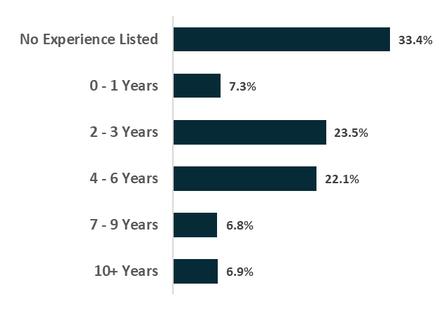
The Business and Finance occupation group with the highest number of Q4 postings (635) was Sales Representatives, Wholesale and Manufacturing, Except Technical and Scientific Products. This was followed by Sales Managers (476); Project Management Specialists, with 407 postings; and Financial Managers (372) While most of the top jobs typically require a bachelor’s degree, the highest-posting occupation group, Sales Representatives, Wholesale and Manufacturing, Except Technical and Scientific Products, requires a high school diploma and offers moderate on-the-job training for those without prior experience

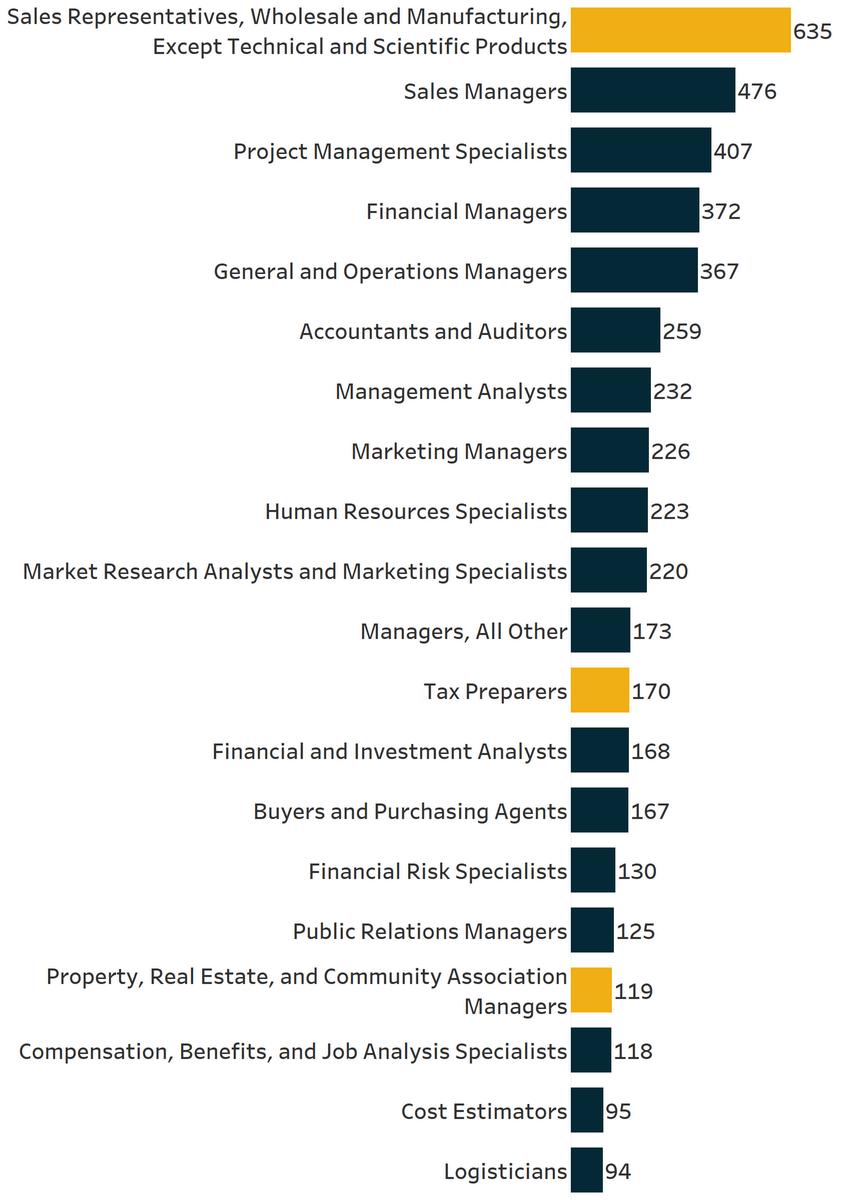
For job seekers able to obtain the required education, Business and Finance occupations offer lucrative opportunities. The top posted occupation, Sales Representatives, Wholesale and Manufacturing, Except Technical and Scientific Products, offers median hourly wages of $35.56 ($73,965 annually), while Sales Managers have a median hourly wage of $77 67 ($161,554 annually) Human Resource Specialists provided the lowest median hourly wage for the top posted jobs in this occupation group at $32 13, which is still significantly above the state median of $22 57
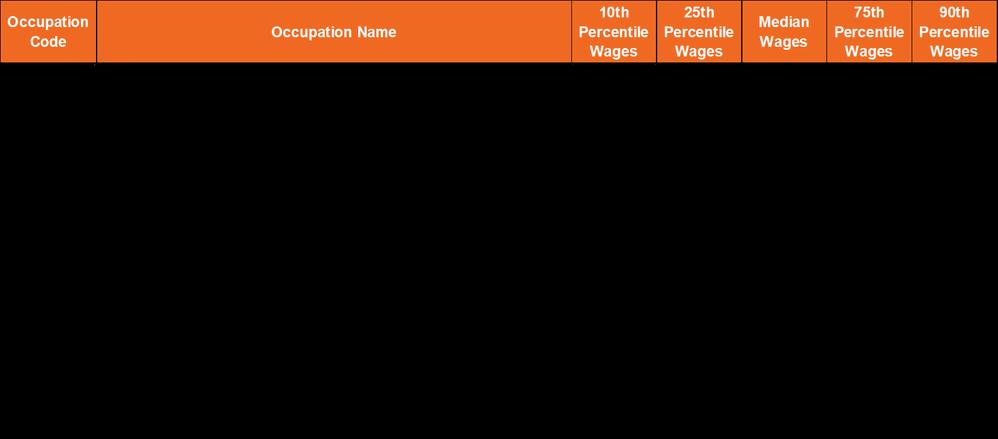
*Not all job postings indicate the required educational attainment level; the percentages indicated may not equal 100 percent.
Energy-related occupations include jobs in engineering, science, mining, and extraction. Workers in this field have a range of skills related to keeping businesses and homes powered. Energy companies employ workers in a variety of occupations, many of which are also included in other WIN occupation groups. Posting data referenced in this section pertains only to job postings from energy-related businesses.
Over Time 2014-2024

148 Energy Workers
The Energy occupation group requires a specialized workforce with specific skills A Bachelor's degree is the most in-demand education level in Q4 with 50 2 percent of 2,116 postings A High School diploma or equivalent is the second most in-demand education level with 15 8 percent, while 13 8 percent require a Master’s degree. The amount of experience required varies widely from none to over ten years, although a majority require at least two years. Many energy occupation postings do not list any specific experience (40.8 percent).


Most high-demand Energy occupations are engineering or management positions requiring a bachelor’s degree. General and Operations Managers has remained the highest in-demand Energy occupation in Q4 with 367 postings Other top posted jobs requiring a bachelor’s degree include Civil Engineers (212 postings), Mechanical Engineers (138 postings), Electrical Engineers (137 postings), and Industrial Production Managers (128 postings)


High demand for engineers and managers in the energy field provides lucrative opportunities for job seekers able to obtain the required educational level The top posted energy job, General and Operations Managers, offers a median hourly wage of $49 90 ($103,792 annually) Construction and technician-focused positions generally have shorter educational requirements and pay higher median wages than similar occupations in other industries.
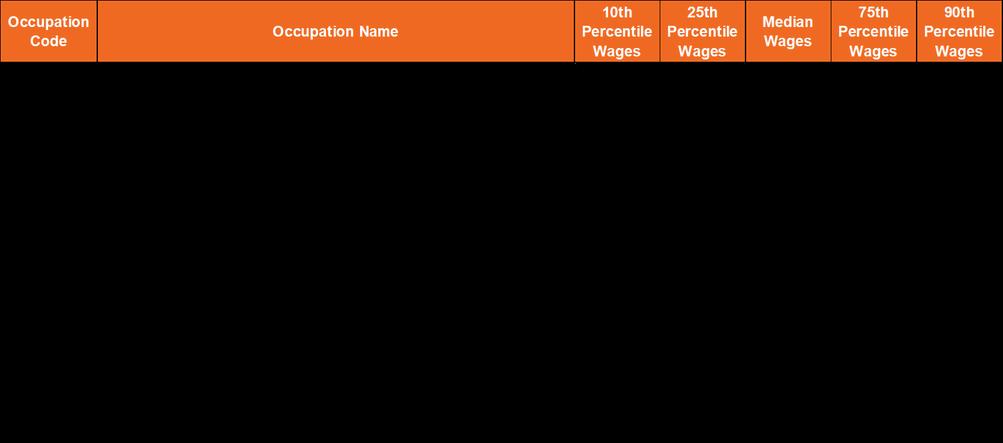
In-Demand Technical Skills
Project Management
Construction
AutoCAD
HVAC
Electrical Engineering
In-Demand Education Level*
High School Diploma: 15 8%
Associate Degree: 7 0%
Bachelor’s Degree: 50 2%
Master’s Degree: 13 8%
Ph D or Professional Degree: 1 7%
Communication
Management
Operations
Leadership
Problem Solving
GPAC
DTE Energy
Actalent
Henry Ford Health SmithGroup
Accenture
City Of Detroit
Imeg Corp
Wayne State University Aerotek
Valid Driver's License Professional Engineer (PE) License Master Of Business Administration (MBA)
LEED Accredited Professional (AP) Engineer in Training
*Not all job postings indicate the required educational attainment level; the percentages indicated may not equal 100 percent.
The Health Care occupation group includes jobs related to health care support and practitioners Employment in this group has seen marginal decline since 2018, although Health Care workers remain in high demand to care for Michigan’s aging population Annually, there are about 3,200 job openings for these positions in Detroit, and this is projected to continue increasing
Employment Over Time 2014-2024
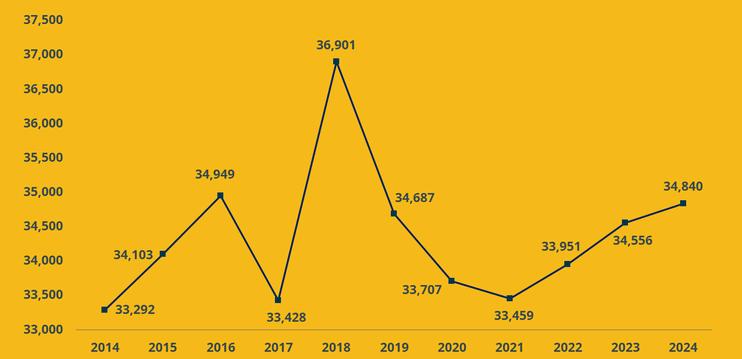
284 Health Care Workers
0.8% increase from 2023
The Health Care occupation group offers many job opportunities for active job seekers at all experience levels. A Bachelor’s degree is the most in-demand education level in Q4, with 1,606 postings. A High School Diploma or equivalent is the second most in-demand education level (1,160 postings). Many postings from this occupation group do not request any specific experience and education level

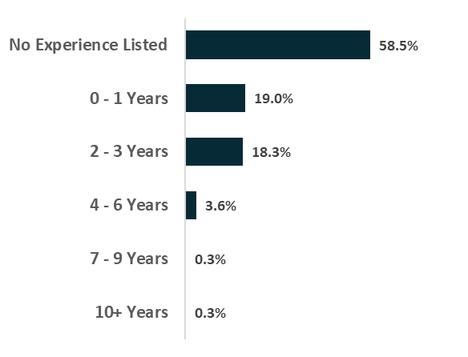
Registered Nurses were the highest in-demand Health Care occupation with 2,361 total postings, a number significantly higher than all the other occupations. A Bachelor’s degree is the most in-demand education level amongst Health Care occupations, indicated in 27.0 percent of postings. A High School Diploma or equivalent accounts for 19.5 percent of posting requirements. Other top posted jobs include Radiologic Technologists and Technicians (283 postings), Health Technologists and Technicians, All Other (270 postings), Magnetic Resonance Imaging Technologists (253 postings), and Clinical Laboratory Technologists and Technicians (212 postings)
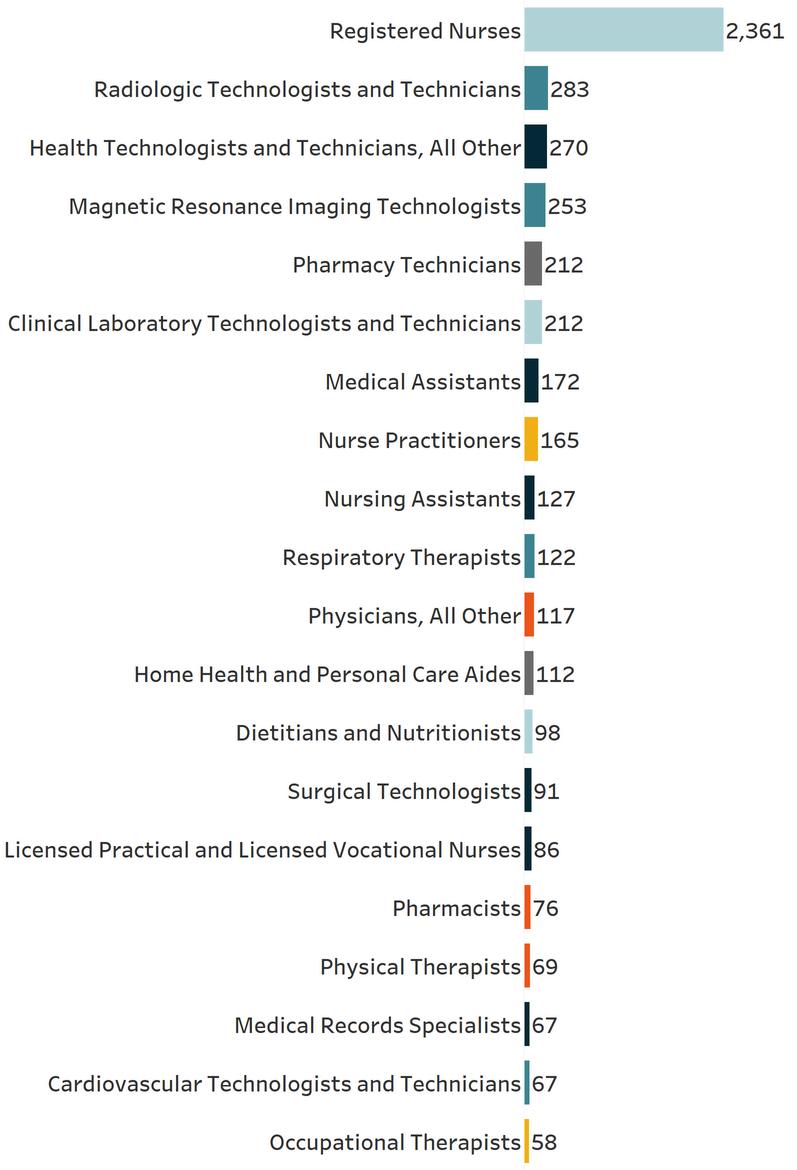
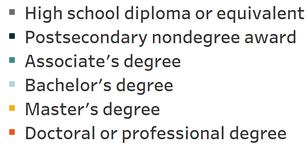
Wages in Health Care are generally higher than the state median hourly wage of $22.57, with pay increasing in line with required education, training, and experience for Health Care’s top jobs. Registered Nurses, the top posted Health Care job in Q4, offers a median hourly wage of $41.28 ($85,862 annually). Although many positions require an Associate degree or higher, there are several jobs above the state minimum wage open to those with a High School diploma or equivalent In-Demand

Nursing
Nursing Care
Patient Preparation
Medical Records
Radiology
High School Diploma: 19.5%
Associate Degree: 15 2%
Bachelor’s Degree: 27 0%
Master’s Degree: 6 8%
Ph D Or professional Degree: 3 8%
Communication
Management
Leadership
Teaching
Decision Making
Henry Ford Health
Detroit Medical Center
Tenet Healthcare
Dmc Sinai Grace Hospital
Dmc Harper University Hospital
Corewell Health
McLaren Health Care
Registered Nurse (RN)
Basic Life Support (BLS)
Certification
Advanced Cardiovascular Life Support (ACLS) Certification
American Registry Of Radiologic Technologists (ARRT) Certified Valid Driver's License
Dmc Children's Hospital Of Michigan
Nursing Network
AMN Healthcare
*Not all job postings indicate the required educational attainment level; the percentages indicated may not equal 100 percent.
Information Technology (IT) jobs include occupations that are associated with entry-level, technical, and professional careers related to the design, development, support and management of hardware, software, multimedia, and systems integration services While the Information Technology group does not currently employ as many individuals as the other groups here, it is quickly growing
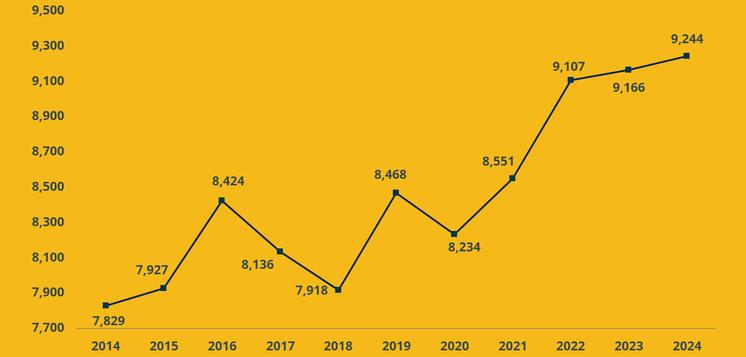
78 Information Technology Workers
0.9% increase from 2023
The Information Technology occupation group offers ample opportunities for active job seekers, with 2,427 postings in Q4. A Bachelor's degree is the most in-demand education level, with an Associate degree the second most required education level. Many IT occupation postings were open to workers with four to six years of experience, with 555 postings. Workers with two to three years of experience are also heavily indemand with 435. Although 776 postings do not request any specific experience level, 104 postings requested workers with zero to one year of experience.
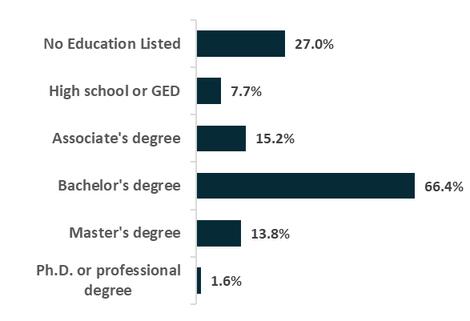
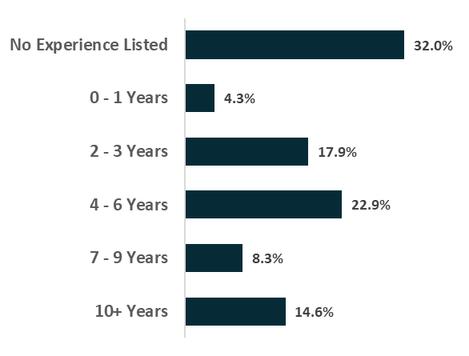
Computer Occupations, All Other, which encompasses emerging occupations such as Web Administrators, and Search Marketing Strategists, were the highest in-demand IT occupation in Q4, with 832 unique postings. Software Developers was the next most in-demand occupation with 586 unique postings. While most of the top jobs require a Bachelor’s degree, Computer User Support Specialists (234 postings) only prefer some college education, but do not require a degree.
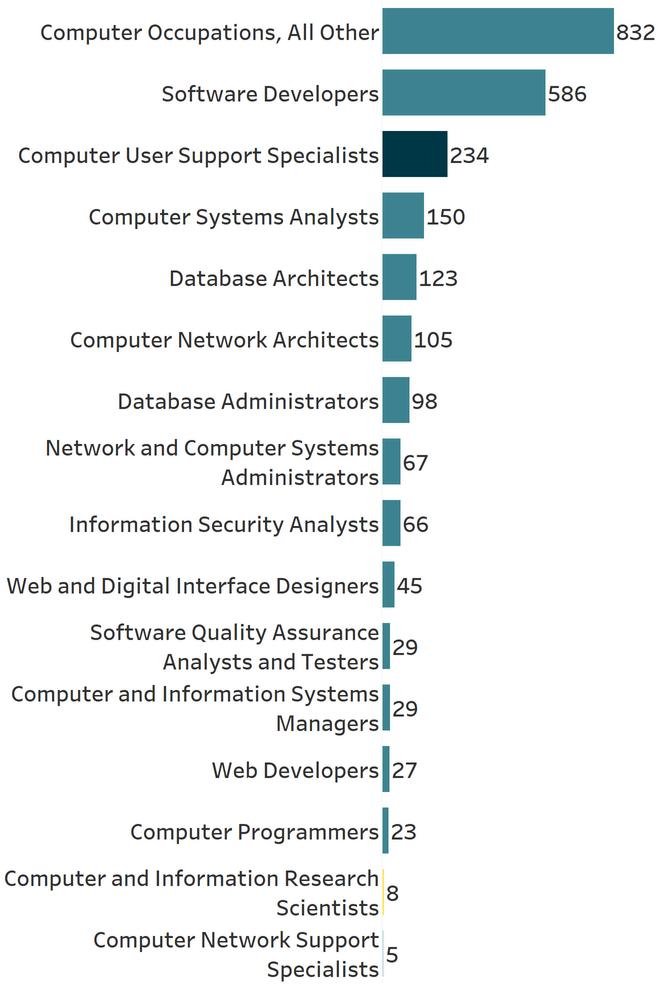
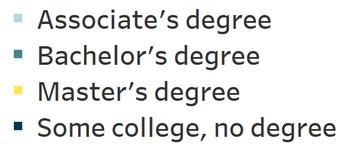
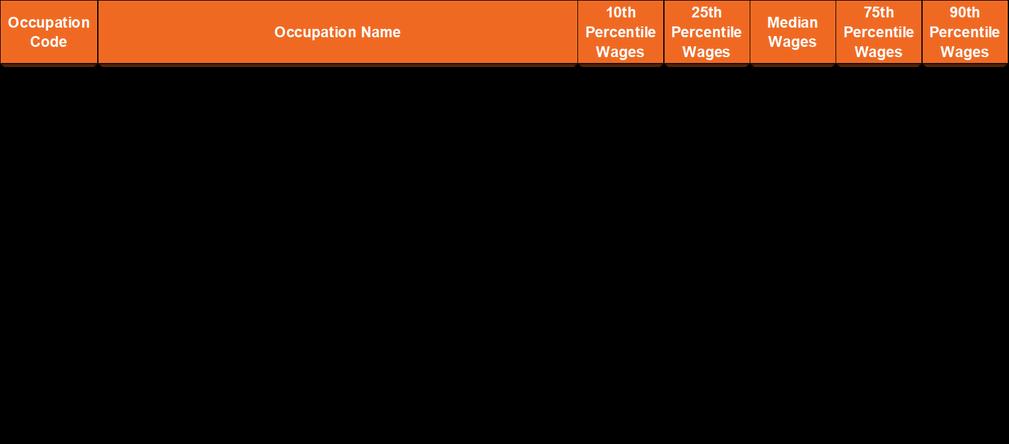
Most IT jobs offer high wages, making for a lucrative opportunity for job seekers able to obtain the additional education related to these jobs. Computer Occupations, All Other, the top posted IT job in Q4, offers a median hourly wage of $48.81 ($101,525 annually). Computer User Support Specialists, which requires some college, no degree, offers a median wage of $29.08 ($60,486 annually). In-Demand
Computer Science
Project Management
Agile Methodology
Automation
Python (Programming Language)
Certified Information Security
Master Of Business Administration (MBA)
High School Diploma: 7.7%
Associate Degree: 15 2%
Bachelor’s Degree: 66 4%
Master’s Degree: 13 8%
Ph D Or professional Degree: 1 6%
*Not all job postings indicate the required educational attainment level; the percentages indicated may not equal 100 percent.
The Skilled Trades and Technicians occupation group includes jobs related to advanced manufacturing Southeast Michigan has one of the highest demands for skilled trades labor, such as CNC machinists and welders, in the country.
NOTE: Skilled trades related to construction and assembly are not included in this cluster, as the focus is on advanced manufacturing only.
Employment Over Time 2014-2024
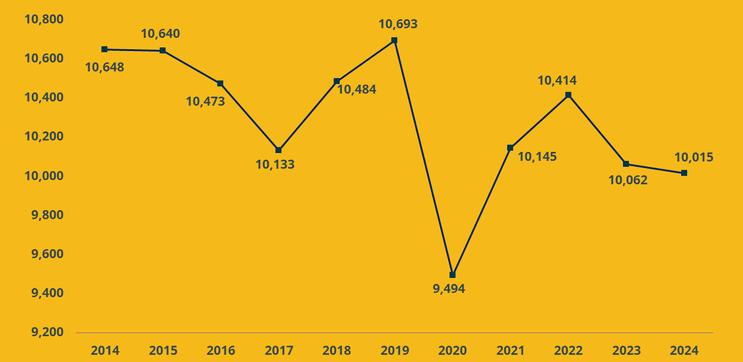
47 Skilled Trades Workers
0.5% decrease from 2023
The Skilled Trades occupation group offers many opportunities for active job seekers in southeast Michigan. A High School diploma or equivalent was the most in-demand education level (377 postings), while a Bachelor's degree was the second most in-demand education level (233 postings) Many Skilled Trades occupation postings were open to workers with zero to three years of experience
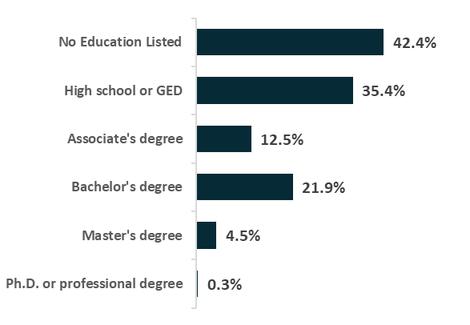
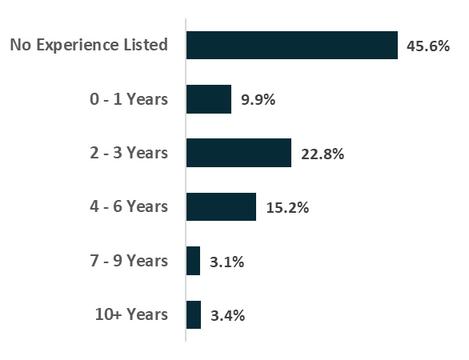
Maintenance and Repair Workers, General was the highest in-demand Skilled Trades occupation during Q4 (416 postings). Other top posted jobs include First-Line Supervisors of Production and Operating Workers (177 postings), Industrial Production Managers (128 postings), Production Workers, All Other (74 postings), and Industrial Machinery Mechanics (44 postings). The majority of this occupation group's top posted jobs required either a high school diploma or equivalent, or an Associate degree and offered moderate to long-term on-the-job training in lieu of experience

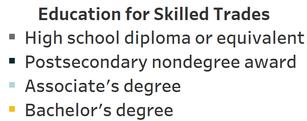
Eight of the top ten in-demand Skilled Trades occupation offer median hourly wages above $22 00 Maintenance and Repair Workers, General, the top posted Skilled Trades job in Q4, offered a median hourly wage of $22 41 ($46,613 annually) Job seekers can expect to see a significant shift in wages based on experience and education requirements: Industrial Production Managers require an additional five years or more of work experience and offers a median hourly wage of $56.71 ($117,957 annually).

